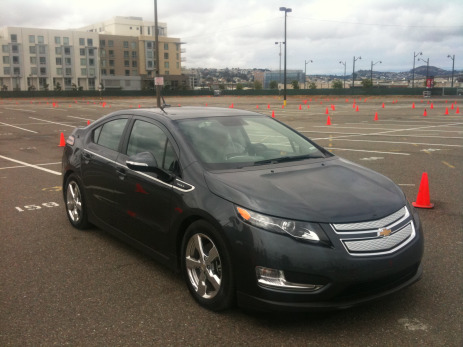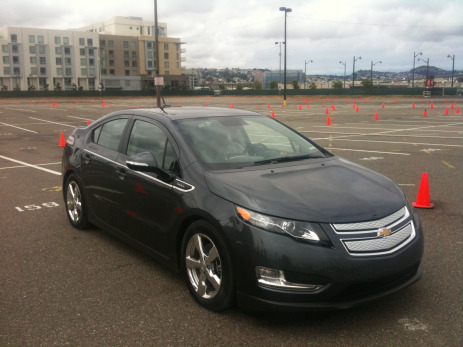 Chevy hopes the Volt takes California by storm.Photo: Todd WoodyIf you happened by an empty parking lot near San Francisco’s waterfront baseball park Tuesday morning, you would have seen some people putting a low-slung black sedan through its paces on a makeshift track outlined by fluorescent orange pylons.
Chevy hopes the Volt takes California by storm.Photo: Todd WoodyIf you happened by an empty parking lot near San Francisco’s waterfront baseball park Tuesday morning, you would have seen some people putting a low-slung black sedan through its paces on a makeshift track outlined by fluorescent orange pylons.
What was remarkable was not so much that the car — the Chevrolet Volt — was electric, but that it hailed from Detroit.
Toyotas, Hondas, BMWs, and Mercedes rule the road in the Golden State’s coastal metropolises, where sightings of American sedans are about as rare as a California condor.
Like Ford, Nissan, Coda Automotive, Think, and other electric automakers, General Motors brought the Volt to San Francisco because, as I wrote in The New York Times recently, this is where the future of the electric car is unfolding first. (Driving home that point was Thursday’s news that Silicon Valley startup Tesla Motors is buying the defunct Bay Area manufacturing plant that previously produced cars for Toyota and General Motors and will now build electric cars in partnership with the Japanese auto giant.)
So the Volt may be GM’s best chance to reintroduce itself to two generations of California drivers who wrote the automaker off as the maker of hopelessly staid and low-quality cars.
“The Volt is going to make people reconsider Chevy and GM again,” Tony Posawatz, Volt vehicle line director, tells me as a group of journalists and influential electric car enthusiasts waited for their turn behind the wheel.
He’s talking about people like me. My first and last American car was the 1979 Chevy Monza I owned as a teenager. An overfed Vega, the car was a mechanical nightmare and I soon replaced it with a Volkswagen Rabbit and then a succession of Hondas and the Toyota RAV4 I currently drive.
Over the years, the only Chevrolets I have driven have been rental car fleet castoffs that did nothing to improve the impression made by the Monza. But getting behind the wheel of the Volt, it’s clear this is not my grandfather’s Chevy.
The car is an engineering test model and not the production version so the interior design and other features may well change by the time the Volt goes on sale later this year. The Volt’s battery pack gives the car a range of 40 miles on a charge. After that, a small gasoline engine kicks in to recharge the battery if you need to go further.
The so-called serial hybrid approach — versus all-electric, no greenhouse gas emissions cars — is GM’s bet that mainstream buyers will want to buy a car that will ease their “range anxiety” and one they can rely on for both running around town and long road trips.
The exterior design is sporty but not space age. GM has opted not to follow the design cues of competitors like Toyota and Nissan, whose all-electric Leaf lets your neighbors know you’ve hit the green road. Inside, the Volt is more fashion forward, loaded with USB ports and other high tech touches.
“The most remarkable thing about it is that it’s unremarkable,” says Nick Pudar, vice president of planning and business development for GM’s OnStar division. “It’s a real vehicle. It’ll meet your every day needs.”
I press a button on the center console and the electric motor comes quietly to life. I put the car in gear and we’re off. Other than the silent running and quick acceleration common to electric cars, it drives like any sporty sedan, handling well and taking corners with ease.
While most electric cars set to hit the market later this year and in early 2011 are compacts, the Volt is a relatively big car.
Posawatz has me switch between various power settings — sport, eco, etc. — but frankly I couldn’t tell the difference.
GM added some Silicon Valley cred this week by cutting a deal with Google to integrate its mapping technology in the Volt’s mobile app. Pudar fires up his phone and the car appears on a map along with his location. If you can’t remember where you parked your Volt, Google will give you walking directions to find it.
Drivers also can use the voice function to say a location — like the Golden Gate Bridge — and the directions can be downloaded to the Volt’s dashboard screen. You can also use a mobile phone to check on the battery charge, charging station locations, lock the doors, etc.
Darryl Siry, a former Tesla marketing executive who has consulted for Coda Automotive, took the Volt for a wheel-squealing spin before me and I later pinged him to get his take.
“I think the car functioned quite well and handled better than I expected when I drove it pretty aggressively,” Siry wrote in an email. “The torque in the motor was very good, which is to be expected, and the motor control algorithm in the sport mode was a pleasant driving experience.”
“Would I consider buying it? Yes, if the pricing is right,” he adds. “If they price it at or near the Leaf I think they will have a very attractive offering. If it is too much higher they will have more of a challenge.”
Nissan will sell the Leaf in the United States for $32,780 — state and federal tax incentives will drop the price to around $20,000 in California. GM has not publicly set the price for the Volt, something that Posawatz says will be revealed in late summer or early fall.
But it seems unlikely GM will match Nissan. “You have to look at the complete value proposition and not be overwhelmed by the price tag,” says Posawatz. “The Volt is loaded up with its 10 airbags, traction control, and ABS all standard.”
As competitors also roll out their electric cars in the Bay Area, two questions remain to be answered — will drivers want an all-electric car or an electric hybrid? And will they buy a Chevy?
For his part, Siry thinks hybrids will have the edge for the next five to 10 years until battery performance improves. (Posawatz says the Volt is designed so that the engine can be swapped for a bigger battery.)
The American car question is harder.
“I think the fact that they are branding it as a Chevrolet will be somewhat of a challenge, but it is a very deliberate effort by GM to have the brand benefits of the Volt accrue to Chevy,” says Siry. “This may increase the challenge they face as they have to carry the weight of a brand image that is not a great fit for the technological innovation and price point, but from GM’s perspective, if they are going to invest over $1 billion in development of the vehicle they want to have it benefit one of their core brands.”
Translation: GM is betting that the average driver will see the Volt as American as baseball, mom, and apple pie.




